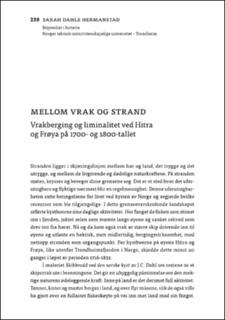| dc.contributor.author | Hermanstad, Sarah Dahle | |
| dc.date.accessioned | 2024-02-27T14:53:55Z | |
| dc.date.available | 2024-02-27T14:53:55Z | |
| dc.date.created | 2021-01-04T08:34:22Z | |
| dc.date.issued | 2020 | |
| dc.identifier.citation | K&K: kultur og klasse. 2020, 48 (130), 239-258. | en_US |
| dc.identifier.issn | 0905-6998 | |
| dc.identifier.uri | https://hdl.handle.net/11250/3120175 | |
| dc.description.abstract | Ever since Arnold van Gennep introduced the concept of liminality in 1909, it has been used in a huge variety of different contexts and on different subjects. The beach has particularly been related to the idea of a liminal zone in the landscape, a place betwixt and between, concerning land and sea, but also on the border of human conduct and behavior. In this article the concept of liminality has been used to understand the role of shipwrecks and salvaging activities, among the inhabitants of the Norwegian islands of Hitra and Frøya during the 18th and 19th centuries.
Liminality can be useful in understanding how shipwrecks became a part of a coastal landscape shaped by unpredictable forces. Not only the ship, but the salvagers and the beach themselves all went through a transformation: a liminal experience. These experiences could be spontaneous or devised, something that happened to you or something you did to yourself, but either way salvaging would become the result of liminal experiences in a liminal landscape. The shipwreck was the token of a way of living in an unpredictable environment. Shipwrecks could become a viable recourse through legal salvaging, or through the right of wreck on the foreshore, which constituted a separate area of the beach. The deadly force of nature that transformed ships to wrecks, was also the same life-bringing force that made life possible. The liminal and the unpredictable was in other words the very foundation of the coastal community. | en_US |
| dc.language.iso | nob | en_US |
| dc.publisher | Syddansk Universitet, Institut for Kulturvidenskaber | en_US |
| dc.rights | Navngivelse 4.0 Internasjonal | * |
| dc.rights.uri | http://creativecommons.org/licenses/by/4.0/deed.no | * |
| dc.title | Mellom vrak og strand: Vrakberging og liminalitet ved Hitra og Frøya på 1700- og 1800-tallet | en_US |
| dc.title.alternative | Mellom vrak og strand: Vrakberging og liminalitet ved Hitra og Frøya på 1700- og 1800-tallet | en_US |
| dc.type | Peer reviewed | en_US |
| dc.type | Journal article | en_US |
| dc.description.version | publishedVersion | en_US |
| dc.source.pagenumber | 239-258 | en_US |
| dc.source.volume | 48 | en_US |
| dc.source.journal | K&K: kultur og klasse | en_US |
| dc.source.issue | 130 | en_US |
| dc.identifier.doi | https://doi.org/10.7146/kok.v48i130.123641 | |
| dc.identifier.cristin | 1864502 | |
| cristin.ispublished | true | |
| cristin.fulltext | original | |
| cristin.qualitycode | 1 | |

